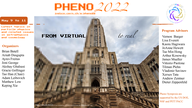Conveners
Cosmology III
- Jae Hyeok Chang (JHU/UMD)
The Cosmic Microwave Background (CMB) spectrum matches that of a perfect blackbody with very high precision. Therefore, any model that distorts this spectrum is highly constrained. Motivated by certain dark sector models, we consider distortions caused by an axion-dark photon-photon coupling. In an axion dark matter background, this coupling converts CMB photons into invisible dark photons. We...
The SKA allows to map the distribution of neutral hydrogen in the
Universe over a vast redshift range. The three-dimensional 21cm power
spectrum found through this map can be used to perform precision tests
not only for several astrophysical phenomena but also for early Universe
cosmology. Even considering only a small redshift range it allows to
significantly improve current...
In this work, we present updated results on an ongoing dark matter search using astrometric weak gravitational lensing. Following the analysis in Mondino et al. (2020), results are reported on a dark matter search using proper motions on stars in the Magellanic Clouds from Gaia's most recent data release. Additionally, we assess our method on star-star lensing, and introduce a parallax...
In the future, Stochastic Gravitational Wave Background can be measured by LISA. If the signal turns out to be produced by a causality-limited process such as a first-order phase transition, then the shape of its low-frequency spectrum would be independent of the details of the production mechanism. The slope of this low-frequency tail would encode information about the equation of state and...
One signature of an expanding universe is the time-variation of the cosmological abundances of its different components. For example, a radiation-dominated universe inevitably gives way to a matter-dominated universe, and critical moments such as matter-radiation equality are fleeting. In this talk, we point out that this lore is not always correct, and that it is possible to obtain a form of...

